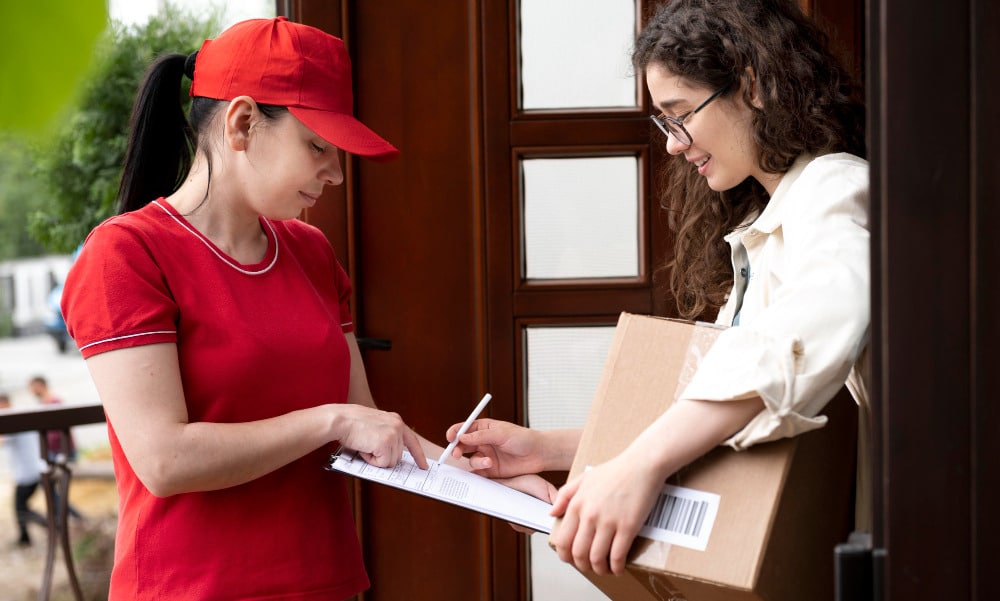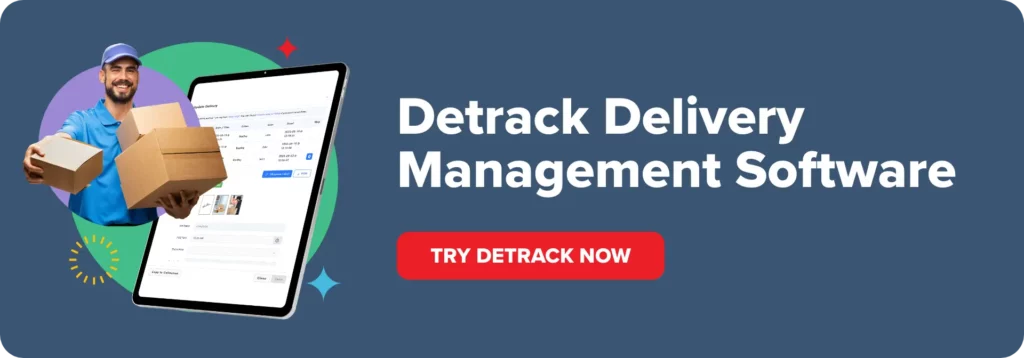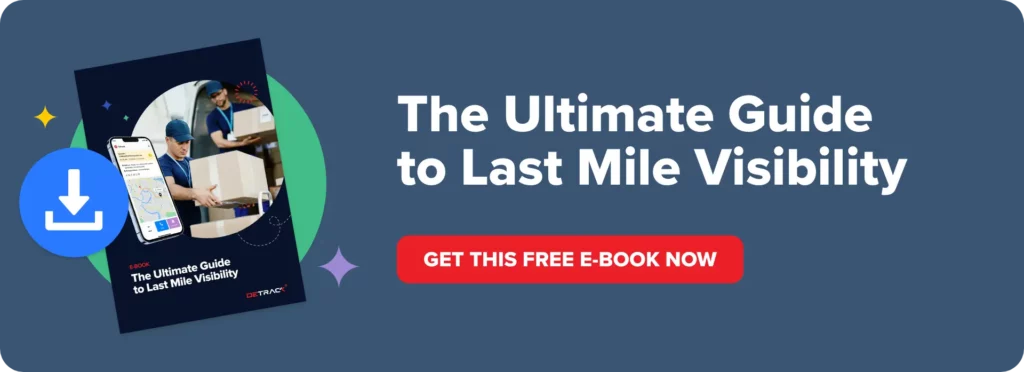The final mile of delivery has become an integral component in the logistics chain, playing a crucial role in meeting customer expectations and ensuring the success of businesses worldwide.
From the moment a product leaves a warehouse to its ultimate destination at a customer’s doorstep, the final mile delivery process encompasses the last leg of the journey, presenting challenges and opportunities for companies aiming to achieve seamless end-to-end logistics.
In this blog, we delve into the significance of final mile delivery, exploring its impact on businesses, the evolving trends reshaping this critical logistics phase, and the innovative strategies adopted to overcome obstacles.
Final Mile Delivery Delays? We Drive Them Away
Get real-time updates, optimize routes, and improve operational efficiency with Detrack!
What is Final Mile Delivery?
Final mile delivery refers to the last leg of the logistics process, where goods are transported from a distribution center or warehouse to their final destination, typically a customer’s doorstep or a retail location.
It is the crucial stage of the supply chain where the product reaches its intended recipient. Despite the term “mile,” this phase can encompass varying distances depending on the specific logistics network and delivery requirements, ranging from a few blocks in urban areas to several miles in suburban or rural locations.
Characterized by its proximity to the end consumer, final mile delivery is important in customer experience and satisfaction. It involves intricate coordination and often requires specialized logistics services tailored to efficiently handle the complexities of delivering items directly to individual homes or businesses.
The Growing Significance of Final Mile Delivery
The significance of final mile delivery in modern logistics has grown exponentially, shaping how businesses operate and transforming customer expectations. This last phase of the supply chain, where goods reach their ultimate destination, has become a pivotal determinant of customer satisfaction, brand loyalty, and operational success.
Consumer behavior underlines its critical role: 75% reward retailers with increased spending and loyalty for a flawless last-mile experience, especially in food and grocery, where 40% consider delivery service a necessity.
Market projections echo its significance: the last mile delivery market is expected to hit USD 424.3 billion by 2030, growing at 10% annually from 2022.
Businesses recognize that optimizing final mile delivery isn’t just about delivering goods—it’s about delivering exceptional experiences. The convergence of technology, logistics innovation, and shifting consumer preferences underscores the need for companies to prioritize efficiency, transparency, and convenience in their final mile operations.
The growing significance of final mile delivery isn’t just a trend; it’s a fundamental shift reshaping the logistics landscape. As businesses strive to meet evolving consumer demands and competitive pressures, mastering the final leg of the delivery journey has become imperative.
Challenges Faced by Businesses in Final Mile Delivery
Businesses navigating final mile delivery encounter a multitude of challenges that significantly impact operations and customer satisfaction:
- Dealing with Remote Locations: Delivering to remote or hard-to-access areas poses logistical hurdles. Limited infrastructure and longer distances can increase delivery times and costs.
- Ensuring Timely Delivery: Meeting delivery deadlines in congested urban areas or during peak demand periods can be challenging. Traffic, weather conditions, and unexpected delays can disrupt schedules.
- Handling Product Returns: Efficiently managing product returns within the final mile can be complex. This process involves coordinating reverse logistics, assessing returned items, and ensuring timely refunds or exchanges.
- Managing Customer Expectations: Meeting diverse customer expectations regarding delivery times, customization, and communication can be demanding. Providing real-time tracking and flexible delivery options is crucial but can also be challenging.
- Cost Implications and Profitability Concerns: The cost of last mile delivery, including labor, fuel, and vehicle maintenance, can significantly impact profitability. Balancing service quality with cost-effectiveness presents an ongoing challenge.

Innovations Transforming Final Mile Logistics
Delivery Management Software
Delivery management software such as Detrack revolutionizes the final mile logistics process by offering a comprehensive suite of features. Real-time tracking capabilities provide businesses and customers with immediate visibility into the status and location of deliveries.
This transparency enhances the customer experience by allowing them to track their orders, minimizing uncertainties, and improving satisfaction.
Additionally, the software’s proof of delivery feature ensures accountability by capturing electronic proof such as recipient signatures, photos, or notes upon delivery, mitigating disputes and fostering trust between businesses and customers.
Autonomous Delivery Solutions
The rise of autonomous vehicles marks a significant leap in final mile logistics innovation. These vehicles, integrated with sophisticated sensors, GPS, and AI, operate without human intervention. They navigate through city streets efficiently, optimizing routes and ensuring timely deliveries.
Autonomous delivery solutions significantly reduce labor costs associated with traditional delivery methods, providing a more cost-effective approach for businesses.
Moreover, their ability to navigate traffic, adapt to changing road conditions, and maintain precise delivery schedules positions them as a promising solution to improve the speed and reliability of last-mile deliveries.
Drone Deliveries
Drone technology has garnered attention as a game-changing innovation in last-mile logistics, particularly for deliveries in remote or congested areas. Drones offer unparalleled speed and agility, bypassing road obstacles and traffic congestion.
They facilitate swift and direct delivery routes, reducing delivery times significantly. Using drones in last-mile delivery enables businesses to offer expedited and time-sensitive delivery options, meeting customer demands for faster service.
While regulatory and logistical challenges remain, the potential for drones to revolutionize the final mile logistics landscape is undeniable.
On-Demand Distribution & Delivery
On-demand delivery platforms have become a flexible solution for businesses seeking scalable and efficient last-mile logistics. These platforms connect businesses with a network of delivery partners or independent contractors, offering vast resources for fulfilling delivery orders.
With the ability to scale delivery operations based on demand fluctuations, businesses can ensure timely and efficient deliveries without requiring extensive in-house logistics infrastructure.
On-demand delivery solutions offer flexibility, cost-effectiveness, and agility in meeting varying delivery needs.
Delivery Robots
Autonomous delivery robots designed for sidewalk or indoor use are transforming the landscape of urban last mile delivery. These robots navigate sidewalks and pedestrian areas, efficiently delivering small to medium-sized packages.
Equipped with advanced sensors and mapping technology, delivery robots avoid obstacles and pedestrian traffic, ensuring secure and timely deliveries.
They offer a scalable solution for businesses, reducing operational costs and delivery times while improving the overall efficiency of last-mile logistics in urban environments.
Electric and Alternative Vehicles
Adopting electric vehicles (EVs) and alternative transportation modes represents a sustainable shift in last-mile delivery. EVs produce lower emissions, contributing to environmental conservation efforts while offering cost savings on fuel and maintenance in the long run.
Businesses leveraging electric and alternative vehicles in their fleets reduce their carbon footprint and position themselves as environmentally conscious, meeting the growing demand for eco-friendly practices in logistics.
Furthermore, governments and organizations incentivizing the adoption of such vehicles encourage their widespread use, promoting sustainability in the final mile logistics sector.
Micro-Fulfillment Centers
Micro-fulfillment centers are compact, automated facilities strategically located in urban areas. These centers act as hubs for order processing, allowing businesses to store inventory closer to end customers.
Micro-fulfillment centers optimize the last-mile delivery process by minimizing the distance between storage and delivery points. They enable faster order management, reducing delivery times and enhancing operational efficiency.
Moreover, these centers integrate automation and robotics, streamlining order fulfillment and allowing for quick and efficient dispatch of orders for final mile delivery.
Crowdshipping
Crowdshipping is a community-based approach that utilizes available resources within a community to assist in delivering packages during regular commutes. Individuals or nearby commuters opt to deliver packages during their everyday travels, optimizing delivery routes and reducing business costs.
By leveraging the shared economy and community collaboration, crowd shipping offers a cost-effective and environmentally friendly solution for last-mile delivery.
It capitalizes on existing resources and maximizes efficiency in delivering packages to their destinations, fostering community engagement and participation in the delivery process.

Best Practices for Streamlining Final Mile Delivery
Prioritize Real-Time Tracking and Visibility
Implement robust systems that offer real-time tracking and visibility throughout the delivery process. Utilize delivery management software or platforms that provide customers and businesses with accurate and updated information on the status and location of their packages. This transparency enhances trust and customer satisfaction, allowing businesses to monitor and manage deliveries effectively.
Optimize Delivery Routes
Leverage technology and route optimization tools to design the most efficient delivery routes. Consider traffic patterns, delivery locations, package sizes, and time windows to minimize travel distances and optimize delivery schedules. Efficient routes reduce fuel consumption, improve delivery times, and enhance operational efficiency.
Enhance Customer Communication
Maintain clear and consistent communication with customers throughout the delivery journey. Implement automated notifications and alerts to inform customers about their delivery status, estimated arrival times, and potential delays. Establishing open lines of communication helps manage expectations and provides customers with a positive delivery experience.
Train and Empower Delivery Personnel
Invest in comprehensive training programs for delivery personnel to ensure they are well-equipped to handle various delivery scenarios. Please provide them with the necessary tools, technology, and communication devices to perform their duties efficiently. Empower them to make informed decisions while prioritizing customer satisfaction.
Plan for Contingencies
Anticipate and plan for potential disruptions or contingencies that may affect deliveries. Develop contingency plans to address unforeseen circumstances such as traffic congestion, adverse weather conditions, or unexpected delays. Having proactive strategies in place helps mitigate risks and ensures smoother delivery operations.
Use Data-Driven Decision Making
Leverage data analytics and insights to make informed decisions regarding delivery operations. Analyze delivery performance metrics, customer feedback, and historical data to identify areas for improvement and optimize processes. Data-driven decision-making enables continuous refinement and enhancement of delivery strategies.
Ensure Transparent Pricing and Fees
Maintain transparency in pricing and fees associated with delivery services. To avoid surprises or misunderstandings, communicate any additional charges, surcharges, or fees to customers upfront. Transparent pricing builds trust and fosters positive customer relationships.
Adapt, Innovate, and Invest in Final Mile Delivery
In conclusion, final mile delivery isn’t just a phase; it’s the culmination of a promise. It’s the commitment businesses make to deliver not just products but seamless experiences. It’s the dedication to adapt to changing landscapes, innovate with technological advancements, and invest strategically to ensure a flawless end-to-end logistics journey.
As businesses pivot towards the future, mastering the final mile is not an option; it’s a necessity. By embracing innovation, investing wisely, and focusing on customer-centric practices, companies can pave the way for success in an increasingly competitive market.
Embrace the evolution of final mile delivery with innovative solutions. Discover how cutting-edge delivery management software like Detrack can transform logistics operations and elevate customer satisfaction.
Final Mile Delivery Delays? We Drive Them Away
Get real-time updates, optimize routes, and improve operational efficiency with Detrack!












